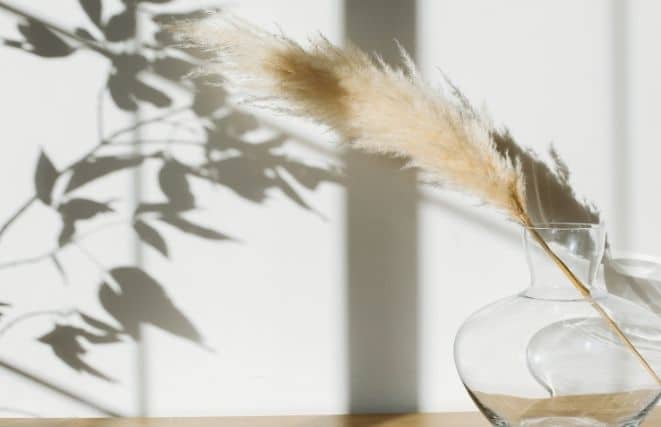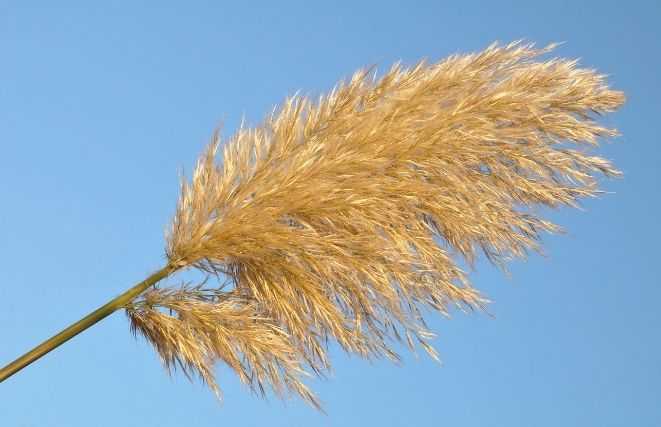Pampas grass (Cortaderia selloana) typically blooms in late summer to early fall, from August to September. However, the blooming period can vary depending on the climate and growing conditions. Some varieties of pampas grass may also bloom earlier or later than others.
The blooming period of pampas grass can last for several weeks, with the plumes retaining their beauty and softness throughout the season.
One fascinating aspect of pampas grass is that even after the blooming season ends, the plumes retain their visual appeal, providing visual interest and texture to the landscape throughout the winter months. As the seasons change and temperatures drop, the plumes gracefully age, taking on a soft beige or golden hue, adding a sense of charm and tranquility to the winter garden.
Flowering Time of Pampas Grass by Seasons
Pampas grass (Cortaderia selloana) is a striking tall ornamental grass known for its magnificent plumes. The flowering time of pampas grass varies by season, adding beauty and allure to different times of the year.
| Season | Flowering Time |
|---|---|
| Spring | As the weather warms up and spring arrives, pampas grass begins to awaken from its winter dormancy. During this season, you’ll notice fresh green growth emerging from the base of the plant. However, the flowering stage is yet to come. |
| Summer | Summer is when pampas grass starts to prepare for its grand show. As the days lengthen and temperatures rise, the grass grows taller and develops lush foliage. While the plumes have not fully formed yet, this is the season of anticipation, as the grass builds energy for the blooming spectacle ahead. |
| Late Summer to Early Fall | The wait is over! Late summer to early fall is the peak flowering time for pampas grass. This is when the grass reveals its stunning plumes, which rise high above the foliage and capture everyone’s attention. The plumes, resembling fluffy feathers, come in various colors, including white, pink, and silver, creating a captivating display. |
| Fall/Winter Transition | As fall arrives and temperatures begin to cool down, pampas grass continues to showcase its beauty. The plumes remain intact, adding texture and interest to the landscape. With the arrival of winter, the grass gracefully ages, and the plumes may take on a softer, beige or golden hue. Even in this transitional period, pampas grass retains its charm and offers visual appeal. |
Pampas grass reveals its blooming glory from late summer to early fall, showcasing its majestic plumes. By understanding the flowering time and providing proper care, you can enjoy the breathtaking display of pampas grass, adding a touch of natural splendor to your landscape throughout the seasons.
What You Must Know About Pampas Grass
If you like Pampas grass, there are a few things you should know. It’s an ideal plant for landscapes on the coast since it can tolerate salt spray without any issues. Additionally, it grows beautifully where there’s much sun.
The plant also works as a landscape. Since it’s so big, many people use it if they want a border on their properties. Its development cycle is also very interesting to see because it goes from white to tawny brown.
Although it grows in the summer and thrives under the sun, you don’t have to worry if you don’t live in a very hot area. You can also grow Pampas grass in a greenhouse or containers.
What Makes Blooming So Beautiful
Cortadeira selloana is famous for being a very big plant. It can reach up to 12 feet tall, which is why it’s so useful if you want it in your landscape.
Pampas grass’ unique characteristics make its blooming process jaw-dropping because it produces large, incredible flowers.
When it blooms, you can see all sorts of wonderful colors. With a range that goes from white to yellow and pink, the plant never stops aweing you.
You should also keep in mind that young plants don’t bloom. Once you plant the seeds, it takes from two to four years for Pampas grass to reach its maturity, and it might even take longer for it to have flowers if it’s located in a dry place.
What You Can Do with Pampas Grass Flowers
Besides using them for your landscape, you can do other things with the flowers. They catch the eye from the first moment you see them, especially because of their white plums. Thus, it’s a perfect plant that you can use for different flower arrangements.
Although the flowers are healthier in a dry area where there’s much sun, many people choose to decorate their gardens and patios with Pampas grass, especially around a pond. Since the plant is so tenacious, it can survive even harsh conditions.

Pampas grass’ perseverance is also seen in the winter, where it can still show its beautiful white plums. Thus, you can also use it to decorate your garden or even your living room if it’s very cold outside.
It doesn’t grow as much if you plant it on a pot, but it can still survive and be healthy. Therefore, you can also use it indoors if you don’t have a garden, patio, or live in an apartment.
What is so special about pampas?
Pampas grass possesses several unique qualities that make it a standout choice for landscaping and garden enthusiasts. Here are some of the special characteristics and features of pampas grass:
- Dramatic Plumes: The most striking feature of pampas grass is its majestic plumes. These plumes, which appear during the flowering season, rise above the foliage and create a visually captivating display. The plumes are feathery and come in various colors, including creamy white, pink, and silver, adding a touch of elegance and charm to any landscape.
- Height and Impact: Pampas grass is known for its impressive size and height. The tall stalks can reach up to 10 feet or more, making a bold statement in the garden. The substantial presence of pampas grass adds vertical interest and creates a focal point that draws the eye, making it a standout feature in any landscape design.
- Texture and Movement: The feathery plumes of pampas grass create a unique texture that adds depth and dimension to the garden. As the wind blows, the plumes sway gracefully, creating a mesmerizing movement that brings life and dynamism to the landscape. This dynamic quality makes pampas grass a visually captivating plant that continuously changes and adds interest to the surroundings.
- Versatility: Pampas grass is highly versatile and can be used in various landscaping applications. It can be planted as a standalone specimen plant, used as a natural screen or divider to create privacy, or incorporated into mixed border plantings for added texture and visual interest. Its versatility allows it to adapt to different garden styles and designs, making it a flexible choice for landscape architects and garden enthusiasts.
- Low Maintenance: Pampas grass is relatively low maintenance, making it an attractive option for busy gardeners. Once established, it is drought-tolerant and requires minimal watering. It is also relatively resistant to pests and diseases. With occasional pruning in late winter or early spring to remove dead foliage and promote new growth, pampas grass can thrive with minimal effort.
- Year-Round Interest: While the flowering season is a highlight, pampas grass offers visual interest throughout the year. Even when the plumes have faded, the grass’s tall and graceful structure, along with its textured foliage, adds architectural appeal to the landscape. Its presence can enhance the winter garden, offering a unique silhouette and texture when other plants may be dormant.
In summary, pampas grass is special due to its dramatic plumes, impressive height, unique texture and movement, versatility in landscaping applications, low maintenance requirements, and year-round visual interest. These qualities contribute to its popularity and make it a standout choice for creating visually stunning and dynamic landscapes.
Are the Flowers Dangerous?
Pampas grass flowers aren’t dangerous to animals or humans. They’re classified as non-toxic, which means you can have the plant around cats, dogs, and even horses.
However, some animals such as dogs and cats could have symptoms such as diarrhea if they eat it, so keep that in mind if you have them around.
FAQ
Pampas grass typically blooms in late summer to early autumn in the UK, typically from August to September. However, this can vary depending on weather conditions and other factors. It is important to note that pampas grass may not bloom during its first year of growth and may take up to three years to reach its full bloom potential.
Pampas grass is a perennial plant, meaning it comes back year after year. However, the appearance of the plant can change depending on the season. In the winter, the foliage may die back and turn brown, while new growth and flowers appear in the spring and summer. So, while pampas grass is not necessarily “year-round” in terms of its appearance, it does persist as a living plant throughout the year.
The flowers of pampas grass can last for several weeks to a few months, depending on various factors. By providing the right conditions and care, you can enjoy the beauty of pampas grass flowers and their captivating plumes for an extended period, enhancing the visual appeal of your garden or landscape.
Final Thoughts
Pampas grass flowers are beautiful and can help you decorate gardens, patios, and even indoors. They bloom in the late summer and can last a long time since the plant’s life cycle ends in 10 to 15 years. Thus, they’re a great choice if you want an eye-catching plant that’s non-toxic to animals and can make your surroundings look better.








